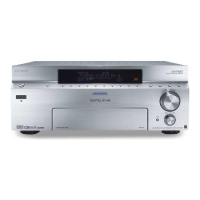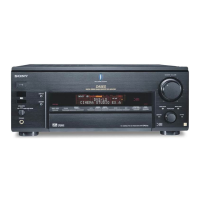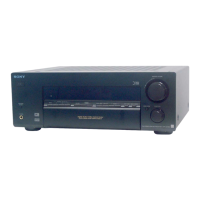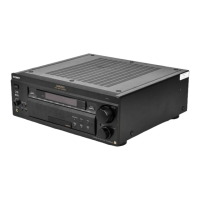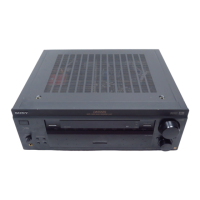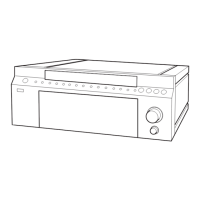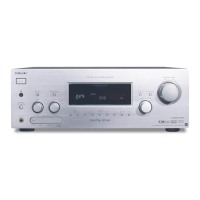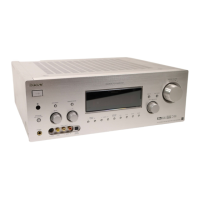Do you have a question about the Sony STR-DA777ES Primary and is the answer not in the manual?
Check unit contents and perform initial setup steps before connecting components.
Connecting FM and AM antennas to the receiver for optimal reception.
Connecting audio sources like CD players, tape decks, and MD/DAT decks.
Connecting video sources such as DVD players, VCRs, and TV tuners.
Connecting digital audio/video sources like DVD players and satellite tuners.
Connecting components with 5.1 channel outputs for immersive surround sound.
Connecting additional components, sub rooms, and using 2ND AUDIO OUT.
Connecting components for system control via S-LINK and CONTROL A1II.
Setting the voltage selector and connecting the AC power cord.
Overview of buttons and controls used for speaker setup.
Connecting speakers to the receiver's terminals for optimal sound.
Precautions to prevent speaker terminal short-circuits and receiver damage.
Information on speaker impedance and selector settings for proper operation.
Essential checks to perform before turning on the receiver for the first time.
How to clear the receiver's memory and reset to factory settings.
Steps to specify speaker types, sizes, and distances for surround sound.
Settings for front and center speaker size and distance.
Setting the size (LARGE/SMALL/NO) for rear speakers.
Setting distances for front, center, rear speakers, and sub woofer.
Adjusting the phase polarity of the sub woofer for optimal bass.
Specifying rear speaker position and height for virtual sound fields.
Configuring speaker roll off frequencies for low cut filters.
Using test tones and controls to balance speaker output levels.
Essential checks to perform before turning on the receiver.
Verifying that all component connections to the receiver are correct.
Identifying and describing the function of front panel controls and indicators.
Using INPUT SELECTOR, AUDIO SPLIT, DIGITAL/ANALOG, and 5.1CH INPUT.
Introduction to receiver's pre-programmed sound modes for surround sound.
Using A.F.D., MODE +/-, 2 CH, and ANALOG DIRECT buttons.
Table detailing effects and notes for various sound field modes.
Explanation of indicators for multi-channel surround displays.
How to navigate menus to adjust receiver settings.
A table detailing menus, parameters, ranges, and descriptions.
Adjusting speaker size, distance, position, and roll off frequencies.
Adjusting equalization for front, center, and rear speakers.
Customizing sound fields with effect level, wall type, and reverb.
Modifying output levels for each speaker, including balance and volume.
Customizing display, input modes, phase polarity, and filters.
Overview of automatic, manual, preset, and direct tuning methods.
Settings for tuning mode, FM mode, and naming preset stations.
Saving custom equalizer and sound field settings for instant recall.
Recording audio or video tapes using the receiver.
Explains the CONTROL A1II system for integrated component operation.
Guide to resolving common problems and difficulties with the receiver.
Definitions of technical terms related to surround sound and audio.
A diagram illustrating the audio signal path within the receiver.
Check unit contents and perform initial setup steps before connecting components.
Connecting FM and AM antennas to the receiver for optimal reception.
Connecting audio sources like CD players, tape decks, and MD/DAT decks.
Connecting video sources such as DVD players, VCRs, and TV tuners.
Connecting digital audio/video sources like DVD players and satellite tuners.
Connecting components with 5.1 channel outputs for immersive surround sound.
Connecting additional components, sub rooms, and using 2ND AUDIO OUT.
Connecting components for system control via S-LINK and CONTROL A1II.
Setting the voltage selector and connecting the AC power cord.
Overview of buttons and controls used for speaker setup.
Connecting speakers to the receiver's terminals for optimal sound.
Precautions to prevent speaker terminal short-circuits and receiver damage.
Information on speaker impedance and selector settings for proper operation.
Essential checks to perform before turning on the receiver for the first time.
How to clear the receiver's memory and reset to factory settings.
Steps to specify speaker types, sizes, and distances for surround sound.
Settings for front and center speaker size and distance.
Setting the size (LARGE/SMALL/NO) for rear speakers.
Setting distances for front, center, rear speakers, and sub woofer.
Adjusting the phase polarity of the sub woofer for optimal bass.
Specifying rear speaker position and height for virtual sound fields.
Configuring speaker roll off frequencies for low cut filters.
Using test tones and controls to balance speaker output levels.
Essential checks to perform before turning on the receiver.
Verifying that all component connections to the receiver are correct.
Identifying and describing the function of front panel controls and indicators.
Using INPUT SELECTOR, AUDIO SPLIT, DIGITAL/ANALOG, and 5.1CH INPUT.
Introduction to receiver's pre-programmed sound modes for surround sound.
Using A.F.D., MODE +/-, 2 CH, and ANALOG DIRECT buttons.
Table detailing effects and notes for various sound field modes.
Explanation of indicators for multi-channel surround displays.
How to navigate menus to adjust receiver settings.
A table detailing menus, parameters, ranges, and descriptions.
Adjusting speaker size, distance, position, and roll off frequencies.
Adjusting equalization for front, center, and rear speakers.
Customizing sound fields with effect level, wall type, and reverb.
Modifying output levels for each speaker, including balance and volume.
Customizing display, input modes, phase polarity, and filters.
Overview of automatic, manual, preset, and direct tuning methods.
Settings for tuning mode, FM mode, and naming preset stations.
Saving custom equalizer and sound field settings for instant recall.
Recording audio or video tapes using the receiver.
Explains the CONTROL A1II system for integrated component operation.
Guide to resolving common problems and difficulties with the receiver.
Definitions of technical terms related to surround sound and audio.
A diagram illustrating the audio signal path within the receiver.
| Channels | 7.1 |
|---|---|
| Total Harmonic Distortion (THD) | 0.05% |
| Input Sensitivity | 150 mV |
| Type | AV Receiver |
| Frequency Response | 10Hz to 100kHz |
| Signal-to-Noise Ratio | 105 dB |
| Digital Inputs | Optical, Coaxial |
| Video Connections | Composite |
| Dimensions | 430 x 175 x 430 mm |
| Weight | 20.2kg |
| Power Output | 120 watts per channel into 8Ω (stereo) |
| Output | Speaker terminals, subwoofer pre-out |

